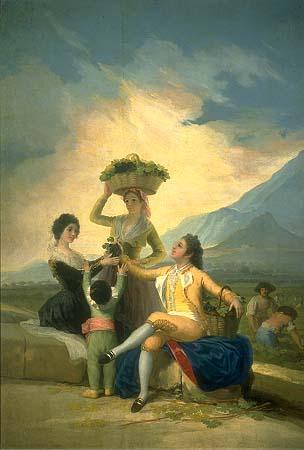Francisco Goya Gallery
Canvas (275 x 190 cms.) Prado Museum, Madrid
Goya began his artistic career in Madrid as a tapestry cartoon painter at the Santa Barbara Royal Tapestry Factory which produced tapestries for the various royal sites. This cartoon was painted by Goya for the king's (Charles III) dining room at the El Pardo Palace (Madrid). Goya created it as part of a series dedicated to the seasons of the year. The wine harvest represents autumn, and the three other paintings representing the remaining seasons, are exhibited in the same Museum´s hall. This is a very serene composition, with the figures in the foreground, grouped as if within a squat triangle, contributing to this. The colouring is very pure and the fields of colour are clearly set apart: this was to facilitate the work of the weavers. The basket on the head of one of the figures is considered one of the finest Spanish still lifes.

viewer |
|
|
| 3rd of MAY 1808 |
| Marquesa de Santiago |
| Bullfight |
| Reclining Nude |
| SATURN DEVOURING HIS SON |
WINE HARVEST |
| FORGE |
Biography
Bulletin Board
Renowned Art
(home)
By the 1780s Goya was Spain's leading painter, specializing in religious pictures and portraits. He left a ruthlessly penetrating record of his patrons and private expressions of introspection, moral objectivity, and caustic commentary on his times. A 1792 illness left Goya deaf and mentally broken. He turned inward and began painting dark, disturbing, private works. His etchings expressed his distaste for the corrupt, fanatical establishment, particularly the Church, for whom he worked. During the Napoleonic wars, Goya recorded his reactions to the occupying French army’s atrocities. By 1814, the repressive Spanish monarchy was restored and Goya resumed painting the royals, whom he portrayed with at times unflattering frankness.
all artists, with thumbnails: by birth year | alphabetically
all artists: by birth year | alphabetically
artists born in the 13th 14th 15th 16th 17th 18th 19th 20th century